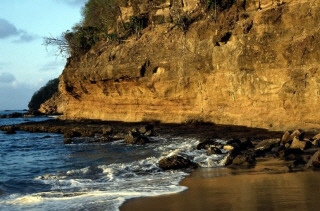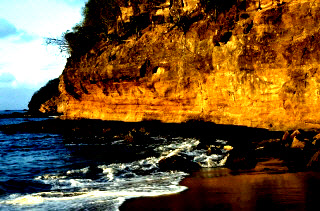CanvasCommand Class
- CanvasCommand combines two images, superimposing one image on another image that is used like a canvas.
-
As an example, if you use the following figure:

And you use the following figure as the canvas image:

And you call CanvasCommand using the following values:
Parameter Value Transparency 90 Emboss 117 XOffset 0 YOffset 0 Flags CanvasCommandFlags.TileShift TilesOffset 0 The following figure results:

-
In the following figure the rafting image has been combined with the canvas image using the same values, except that the CanvasCommandFlags.TileFit flag is used and so instead of tiling the canvas image has been stretched to fit the dimensions of the rafting image:

-
Other commands that allow you to combine images include:
BumpCommand
CombineCommand
CombineWrapCommand
TextureAlphaBlendCommand
UnderlayCommand
For more information on this and other commands that can be used to combine images, Refer to Introduction to Image Processing With LEADTOOLS.
-
This command supports 12-bit and 16-bit grayscale and 48-bit and 64-bit color images. Support for 12-bit and 16-bit grayscale and 48-bit and 64-bit color images is available only in the Document/Medical toolkits.
- This command does not support signed data images.
- This command does not support 32-bit grayscale images.
For more information Refer to Applying Artistic Effects.
Canvas Function - Before

Canvas Function - After

View additional platform support for this Canvas function.
This procedure run a CanvasCommand of the image using canvasImage.
using Leadtools;using Leadtools.Codecs;using Leadtools.ImageProcessing.SpecialEffects;public void CanvasCommandExample(){// Load an imageRasterCodecs codecs = new RasterCodecs();codecs.ThrowExceptionsOnInvalidImages = true;RasterImage image = codecs.Load(Path.Combine(LEAD_VARS.ImagesDir, "cannon.jpg"));RasterImage canvasImage = codecs.Load(Path.Combine(LEAD_VARS.ImagesDir, "ULAY1.BMP"));// Prepaire the commandCanvasCommand canvasCommand = new CanvasCommand();canvasCommand.CanvasImage = canvasImage;canvasCommand.Emboss = 100;canvasCommand.Transparency = 100;canvasCommand.XOffset = 10;canvasCommand.YOffset = 10;canvasCommand.TileOffset = 20;canvasCommand.Flags = CanvasCommandFlags.TileShift;// Apply the commandcanvasCommand.Run(image);codecs.Save(image, Path.Combine(LEAD_VARS.ImagesDir, "Result.jpg"), RasterImageFormat.Jpeg, 24);}static class LEAD_VARS{public const string ImagesDir = @"C:\LEADTOOLS22\Resources\Images";}
Reference
Leadtools.ImageProcessing.SpecialEffects Namespace
Leadtools.ImageProcessing.Effects.EmbossCommand
Leadtools.ImageProcessing.Color.ChangeHueSaturationIntensityCommand
ColoredPencilExtendedCommand Class
Leadtools.ImageProcessing.Color.ColorReplaceCommand
Leadtools.ImageProcessing.Color.ColorThresholdCommand
Leadtools.ImageProcessing.Effects.CombineCommand
Leadtools.ImageProcessing.CombineWarpCommand
Leadtools.ImageProcessing.Core.DiscreteFourierTransformCommand
Leadtools.ImageProcessing.Effects.DirectionEdgeStatisticalCommand
Leadtools.ImageProcessing.Core.FastFourierTransformCommand
Leadtools.ImageProcessing.Core.FrequencyFilterCommand
Leadtools.ImageProcessing.Core.FrequencyFilterMaskCommand
Leadtools.ImageProcessing.Core.FourierTransformDisplayCommand
Leadtools.ImageProcessing.Effects.StatisticsInformationCommand
Leadtools.ImageProcessing.Effects.FeretsDiameterCommand
Leadtools.ImageProcessing.Effects.ObjectInformationCommand
Leadtools.ImageProcessing.Effects.RegionContourPointsCommand
Leadtools.ImageProcessing.Color.MathematicalFunctionCommand
Leadtools.ImageProcessing.Color.SegmentCommand
Leadtools.ImageProcessing.Core.SubtractBackgroundCommand
